ECO mode Alfa Romeo 4C 2021 Instructieboek (in Dutch)
[x] Cancel search | Manufacturer: ALFA ROMEO, Model Year: 2021, Model line: 4C, Model: Alfa Romeo 4C 2021Pages: 156, PDF Size: 3.06 MB
Page 13 of 156
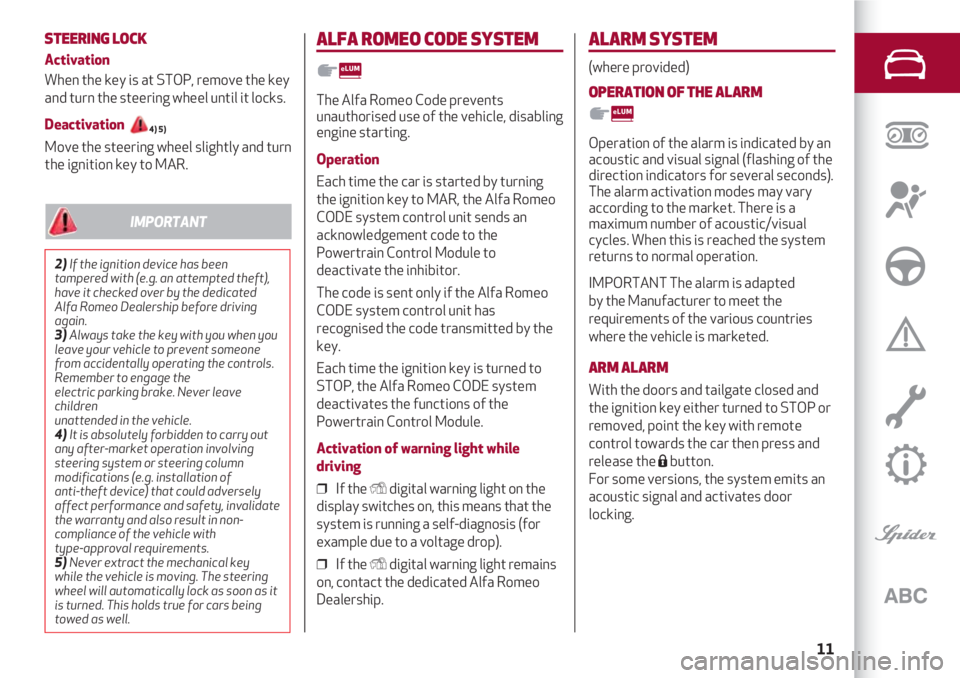
11
STEERING LOCK
Activation
When the key is at STOP, remove the key
and turn the steering wheel until it locks.
Deactivation 4) 5)
Move the steering wheel slightly and turn
the ignition key to MAR.
2)If the ignition device has been
tampered with (e.g. an attempted theft),
have it checked over by the dedicated
Alfa Romeo Dealership before driving
again.
3)Always take the key with you when you
leave your vehicle to prevent someone
from accidentally operating the controls.
Remember to engage the
electric parking brake. Never leave
children
unattended in the vehicle.
4)It is absolutely forbidden to carry out
any after-market operation involving
steering system or steering column
modifications (e.g. installation of
anti-theft device) that could adversely
affect performance and safety, invalidate
the warranty and also result in non-
compliance of the vehicle with
type-approval requirements.
5)Never extract the mechanical key
while the vehicle is moving. The steering
wheel will automatically lock as soon as it
is turned. This holds true for cars being
towed as well.
IMPORTANT
ALFA ROMEO CODE SYSTEM
The Alfa Romeo Code prevents
unauthorised use of the vehicle, disabling
engine starting.
Operation
Each time the car is started by turning
the ignition key to MAR, the Alfa Romeo
CODE system control unit sends an
acknowledgement code to the
Powertrain Control Module to
deactivate the inhibitor.
The code is sent only if the Alfa Romeo
CODE system control unit has
recognised the code transmitted by the
key.
Each time the ignition key is turned to
STOP, the Alfa Romeo CODE system
deactivates the functions of the
Powertrain Control Module.
Activation of warning light while
driving
❒ If the Ydigital warning light on the
display switches on, this means that the
system is running a self-diagnosis (for
example due to a voltage drop).
❒ If the Ydigital warning light remains
on, contact the dedicated Alfa Romeo
Dealership.
ALARM SYSTEM
(where provided)
OPERATION OF THE ALARM
Operation of the alarm is indicated by an
acoustic and visual signal (flashing of the
direction indicators for several seconds).
The alarm activation modes may vary
according to the market. There is a
maximum number of acoustic/visual
cycles. When this is reached the system
returns to normal operation.
IMPORTANT The alarm is adapted
by the Manufacturer to meet the
requirements of the various countries
where the vehicle is marketed.
ARM ALARM
With the doors and tailgate closed and
the ignition key either turned to STOP or
removed, point the key with remote
control towards the car then press and
release the Ábutton.
For some versions, the system emits an
acoustic signal and activates door
locking.
Page 20 of 156
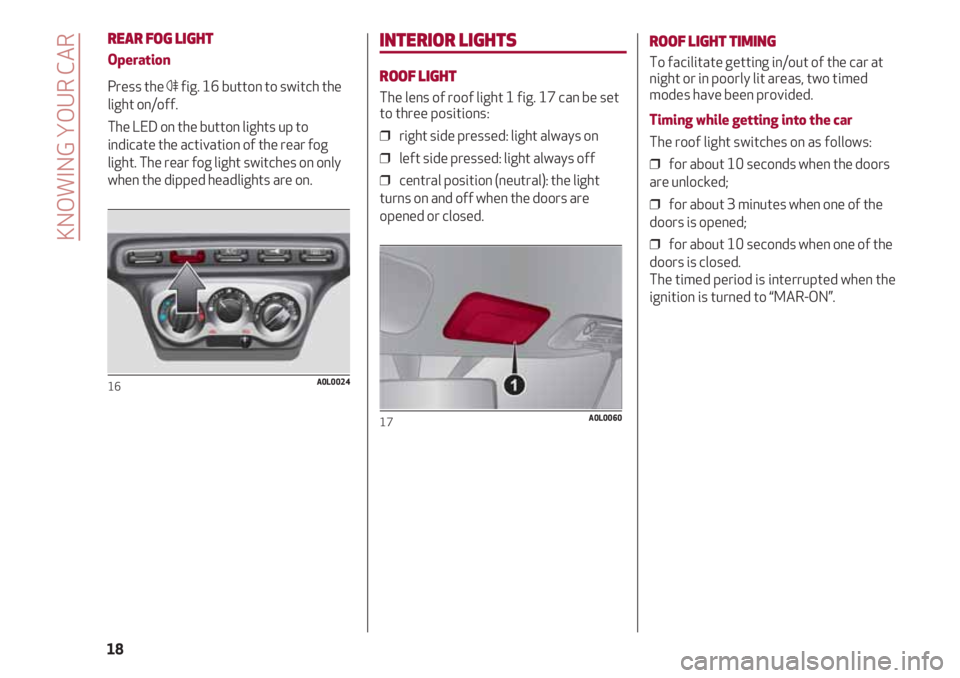
REAR FOG LIGHT
Operation
Press the 4fig. 16 button to switch the
light on/off.
The LED on the button lights up to
indicate the activation of the rear fog
light. The rear fog light switches on only
when the dipped headlights are on.
16A0L0024
INTERIOR LIGHTS
ROOF LIGHT
The lens of roof light 1 fig. 17 can be set
to three positions:
❒ right side pressed: light always on
❒ left side pressed: light always off
❒ central position (neutral): the light
turns on and off when the doors are
opened or closed.
17A0L0060
ROOF LIGHT TIMING
To facilitate getting in/out of the car at
night or in poorly lit areas, two timed
modes have been provided.
Timing while getting into the car
The roof light switches on as follows:
❒ for about 10 seconds when the doors
are unlocked;
❒ for about 3 minutes when one of the
doors is opened;
❒ for about 10 seconds when one of the
doors is closed.
The timed period is interrupted when the
ignition is turned to “MAR-ON”.
KNOWING YOUR CAR
18
Page 29 of 156
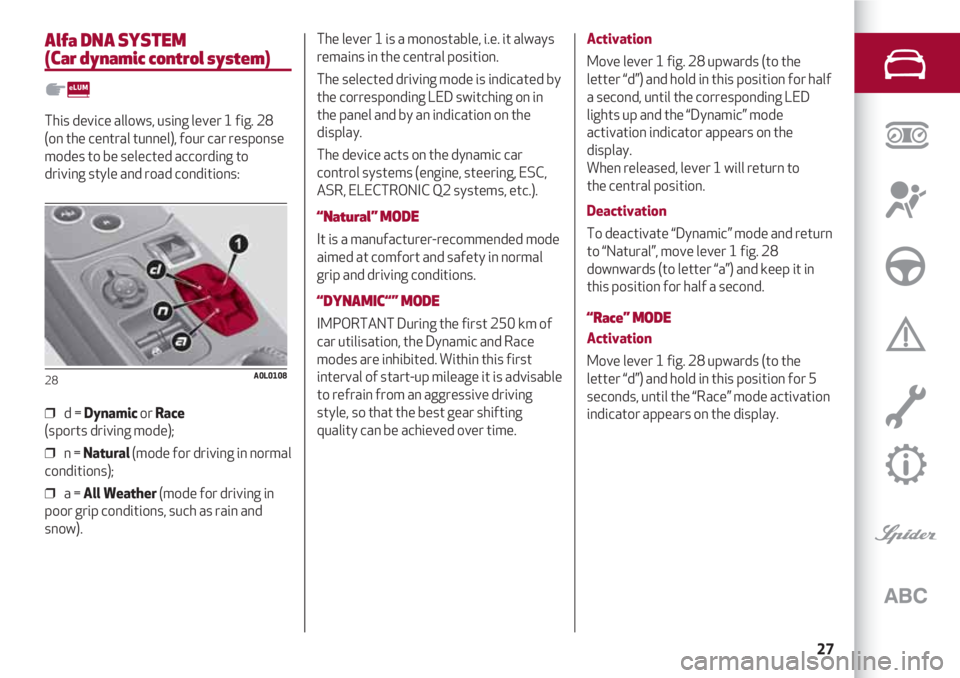
27
Alfa DNA SYSTEM
(Car dynamic control system)
This device allows, using lever 1 fig. 28
(on the central tunnel), four car response
modes to be selected according to
driving style and road conditions:
❒ d = Dynamicor Race
(sports driving mode);
❒ n = Natural(mode for driving in normal
conditions);
❒ a = All Weather(mode for driving in
poor grip conditions, such as rain and
snow).
28A0L0108
The lever 1 is a monostable, i.e. it always
remains in the central position.
The selected driving mode is indicated by
the corresponding LED switching on in
the panel and by an indication on the
display.
The device acts on the dynamic car
control systems (engine, steering, ESC,
ASR, ELECTRONIC Q2 systems, etc.).
“Natural” MODE
It is a manufacturer-recommended mode
aimed at comfort and safety in normal
grip and driving conditions.
“DYNAMIC“” MODE
IMPORTANT During the first 250 km of
car utilisation, the Dynamic and Race
modes are inhibited. Within this first
interval of start-up mileage it is advisable
to refrain from an aggressive driving
style, so that the best gear shifting
quality can be achieved over time.
Activation
Move lever 1 fig. 28 upwards (to the
letter “d”) and hold in this position for half
a second, until the corresponding LED
lights up and the “Dynamic” mode
activation indicator appears on the
display.
When released, lever 1 will return to
the central position.
Deactivation
To deactivate “Dynamic” mode and return
to “Natural”, move lever 1 fig. 28
downwards (to letter “a”) and keep it in
this position for half a second.
“Race” MODE
Activation
Move lever 1 fig. 28 upwards (to the
letter “d”) and hold in this position for 5
seconds, until the “Race” mode activation
indicator appears on the display.
Page 30 of 156
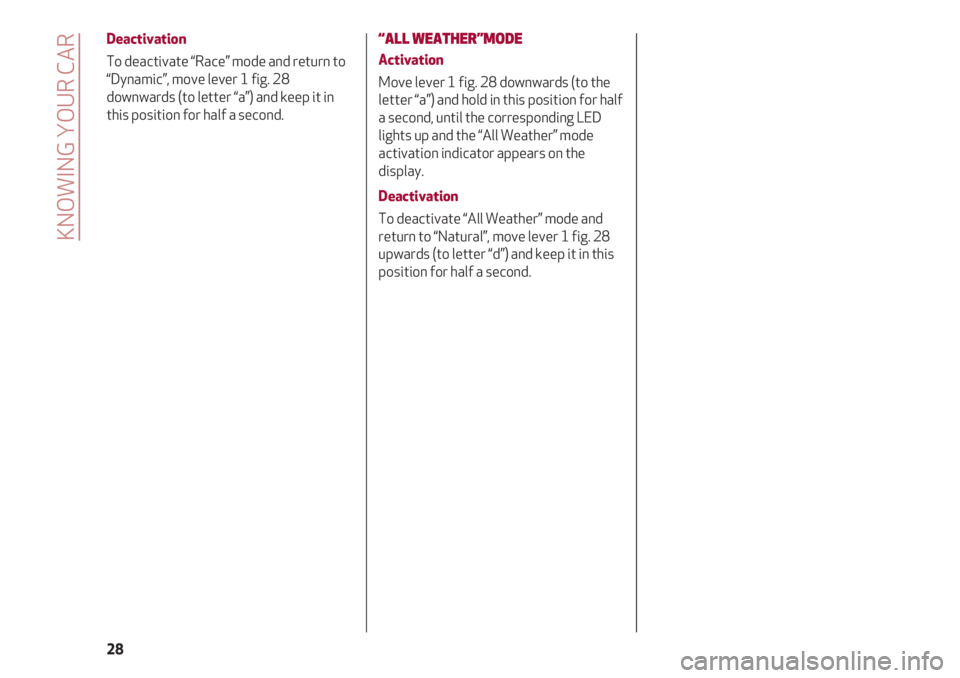
KNOWING YOUR CAR
28
Deactivation
To deactivate “Race” mode and return to
“Dynamic”, move lever 1 fig. 28
downwards (to letter “a”) and keep it in
this position for half a second.
“ALL WEATHER”MODE
Activation
Move lever 1 fig. 28 downwards (to the
letter “a”) and hold in this position for half
a second, until the corresponding LED
lights up and the “All Weather” mode
activation indicator appears on the
display.
Deactivation
To deactivate “All Weather” mode and
return to “Natural”, move lever 1 fig. 28
upwards (to letter “d”) and keep it in this
position for half a second.
Page 43 of 156
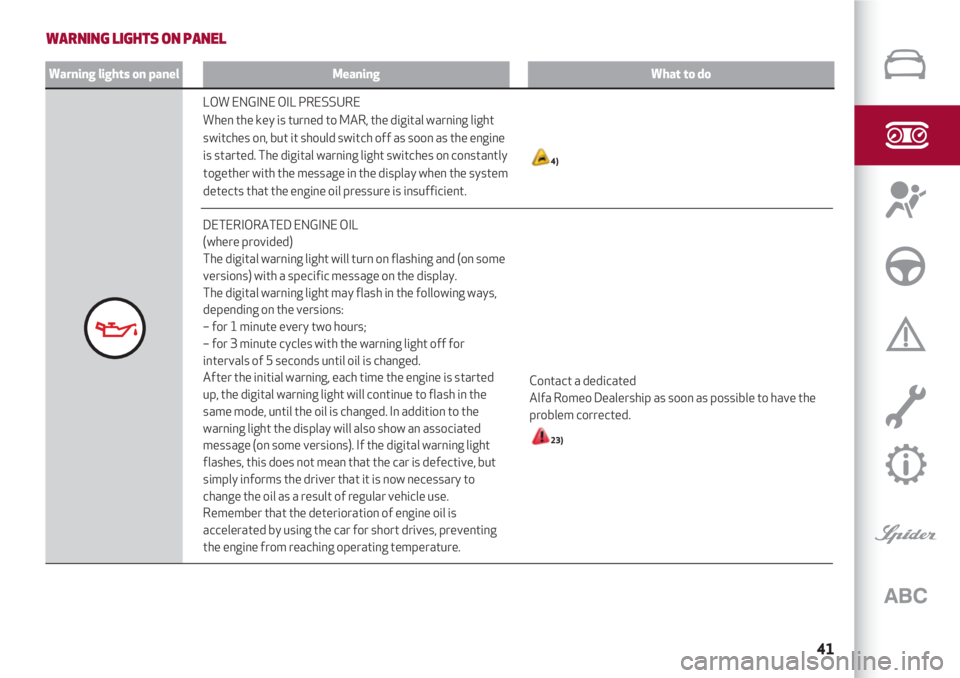
41
WARNING LIGHTS ON PANEL
Warning lights on panelMeaningWhat to do
LOW ENGINE OIL PRESSURE
When the key is turned to MAR, the digital warning light
switches on, but it should switch off as soon as the engine
is started. The digital warning light switches on constantly
together with the message in the display when the system
detects that the engine oil pressure is insufficient.
DETERIORATED ENGINE OIL
(where provided)
The digital warning light will turn on flashing and (on some
versions) with a specific message on the display.
The digital warning light may flash in the following ways,
depending on the versions:
– for 1 minute every two hours;
– for 3 minute cycles with the warning light off for
intervals of 5 seconds until oil is changed.
After the initial warning, each time the engine is started
up, the digital warning light will continue to flash in the
same mode, until the oil is changed. In addition to the
warning light the display will also show an associated
message (on some versions). If the digital warning light
flashes, this does not mean that the car is defective, but
simply informs the driver that it is now necessary to
change the oil as a result of regular vehicle use.
Remember that the deterioration of engine oil is
accelerated by using the car for short drives, preventing
the engine from reaching operating temperature.
4)
Contact a dedicated
Alfa Romeo Dealership as soon as possible to have the
problem corrected.
23)
Page 72 of 156
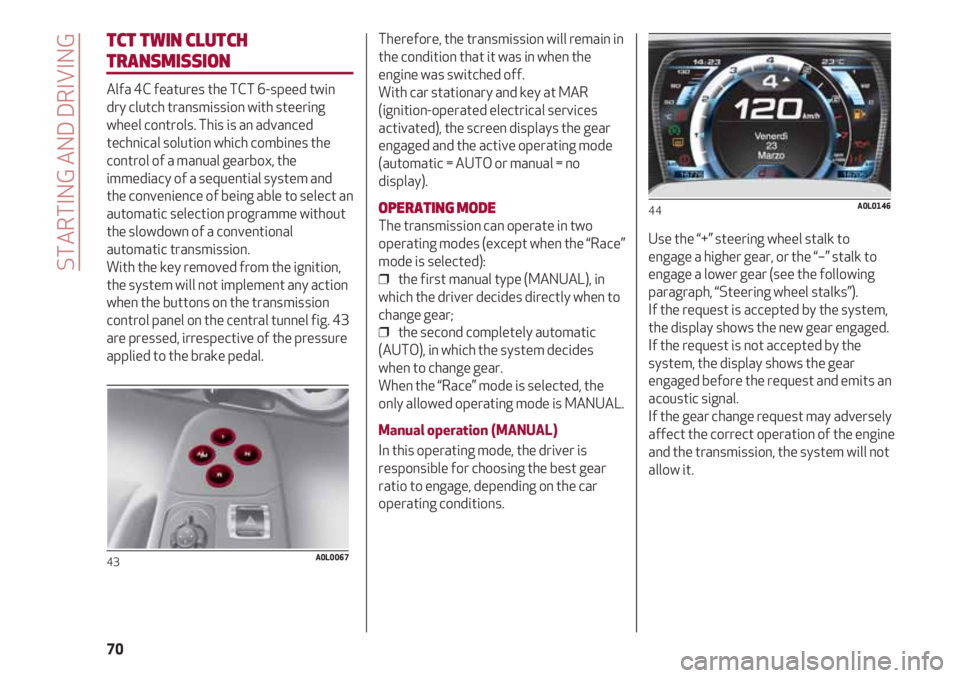
STARTING AND DRIVING
70
TCT TWIN CLUTCH
TRANSMISSION
Alfa 4C features the TCT 6-speed twin
dry clutch transmission with steering
wheel controls. This is an advanced
technical solution which combines the
control of a manual gearbox, the
immediacy of a sequential system and
the convenience of being able to select an
automatic selection programme without
the slowdown of a conventional
automatic transmission.
With the key removed from the ignition,
the system will not implement any action
when the buttons on the transmission
control panel on the central tunnel fig. 43
are pressed, irrespective of the pressure
applied to the brake pedal.
43A0L0067
Therefore, the transmission will remain in
the condition that it was in when the
engine was switched off.
With car stationary and key at MAR
(ignition-operated electrical services
activated), the screen displays the gear
engaged and the active operating mode
(automatic = AUTO or manual = no
display).
OPERATING MODE
The transmission can operate in two
operating modes (except when the “Race”
mode is selected):
❒ the first manual type (MANUAL), in
which the driver decides directly when to
change gear;
❒ the second completely automatic
(AUTO), in which the system decides
when to change gear.
When the “Race” mode is selected, the
only allowed operating mode is MANUAL.
Manual operation (MANUAL)
In this operating mode, the driver is
responsible for choosing the best gear
ratio to engage, depending on the car
operating conditions.Use the “+” steering wheel stalk to
engage a higher gear, or the “–” stalk to
engage a lower gear (see the following
paragraph, “Steering wheel stalks”).
If the request is accepted by the system,
the display shows the new gear engaged.
If the request is not accepted by the
system, the display shows the gear
engaged before the request and emits an
acoustic signal.
If the gear change request may adversely
affect the correct operation of the engine
and the transmission, the system will not
allow it.
44A0L0146
Page 73 of 156
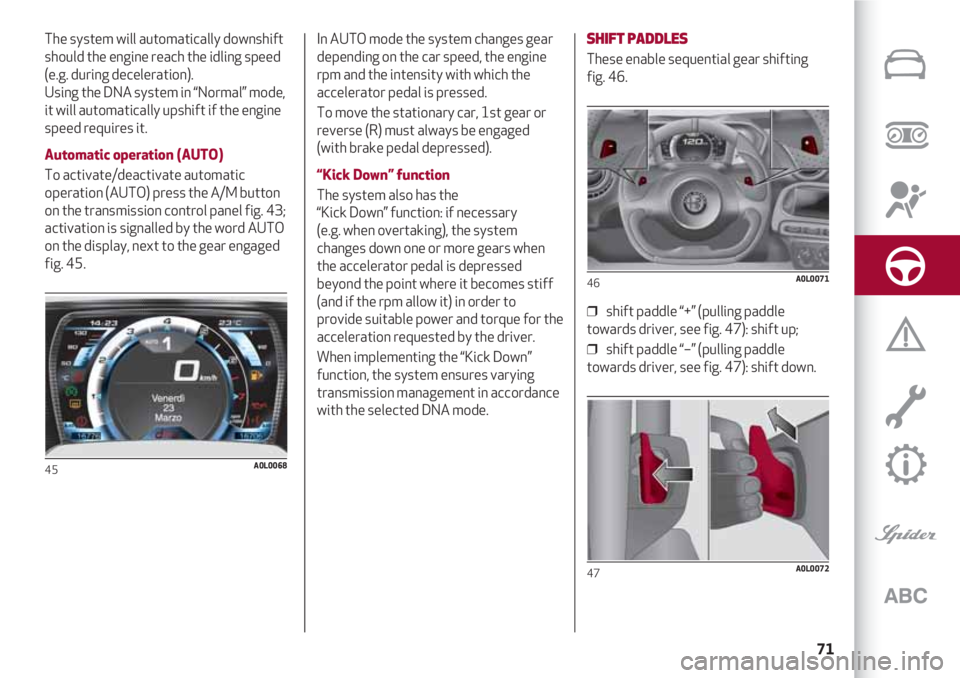
71
The system will automatically downshift
should the engine reach the idling speed
(e.g. during deceleration).
Using the DNA system in “Normal” mode,
it will automatically upshift if the engine
speed requires it.
Automatic operation (AUTO)
To activate/deactivate automatic
operation (AUTO) press the A/M button
on the transmission control panel fig. 43;
activation is signalled by the word AUTO
on the display, next to the gear engaged
fig. 45.
45A0L0068
In AUTO mode the system changes gear
depending on the car speed, the engine
rpm and the intensity with which the
accelerator pedal is pressed.
To move the stationary car, 1st gear or
reverse (R) must always be engaged
(with brake pedal depressed).
“Kick Down” function
The system also has the
“Kick Down” function: if necessary
(e.g. when overtaking), the system
changes down one or more gears when
the accelerator pedal is depressed
beyond the point where it becomes stiff
(and if the rpm allow it) in order to
provide suitable power and torque for the
acceleration requested by the driver.
When implementing the “Kick Down”
function, the system ensures varying
transmission management in accordance
with the selected DNA mode.
SHIFT PADDLES
These enable sequential gear shifting
fig. 46.
❒ shift paddle “+” (pulling paddle
towards driver, see fig. 47): shift up;
❒ shift paddle “–” (pulling paddle
towards driver, see fig. 47): shift down.
46A0L0071
47A0L0072
Page 74 of 156

STARTING AND DRIVING
72
The shifting up or down is only permitted
if the engine revs allow it.
STARTING THE ENGINE
To start the engine press the brake pedal:
the system engages neutral (N)
automatically.
After the starting procedure, 1st gear (1)
or reverse (R) can be engaged.
Irrespective of the mode selected
(AUTO/MANUAL), to engage 1st gear or
reverse (R), it is necessary to press the
brake pedal and press the 1 button on the
transmission control panel (or the “+”
steering wheel stalk) to engage 1st gear
or the R button to engage reverse.
When 1st gear is engaged, the system
sets itself to AUTO mode.
Neutral (N) can be engaged again by
pressing the N button with the brake
pedal pressed.
When the 1, N or R buttons are pressed
(or “+” steering wheel stalk is operated)
without pressing the brake pedal, no gear
change request is implemented by the
system.
IMPORTANT Reverse cannot be engaged
by pressing the “-” stalk on the steering
wheel.
Important notes
To start in presence of a gearbox fault
(see “Warning lights and messages”
paragraph in the “Knowing the instrument
panel” chapter), run the
“Delayed start-up” procedure:
turn the key to the AVV position for at
least 7 seconds with the brake depressed
and the engine will start.
The system will remain in “recovery”
condition.
If the engine does not start, contact a
dedicated Alfa Romeo Dealership.
When the driver’s door is opened, the
system activates the hydraulic
components so that they are prepared
for the subsequent engine starting.
MOVING THE CAR
The car can set off both in 1st gear and
reverse (R).
The gears can only be engaged by
pressing the brake pedal. If the brake
pedal is not depressed, the display will
show a dedicated message.It is not possible to set off in a higher gear
than 1st: if this is attempted, the display
shows a dedicated message.
When setting off on a medium-steep
incline, it is advisable to engage the
handbrake.
Engaging 1st gear
Proceed as follows:
❒ press the brake pedal;
❒ press the 1 button on the
transmission control panel;
❒ release the brake pedal and press the
accelerator pedal.
Engaging reverse (R)
Reverse (R) can only be engaged with car
stationary and brake pedal pressed.
Proceed as follows:
❒ press the brake pedal (car completely
stationary);
❒ press button R on the
gearbox panel;
❒ release the brake pedal and press the
accelerator pedal.
When reverse is engaged on some
versions, the system emits an acoustic
signal.
If the brake pedal is not depressed (and
the vehicle is stationary), the display will
show a dedicated message and the
system will automatically engage neutral
(N).
Page 75 of 156
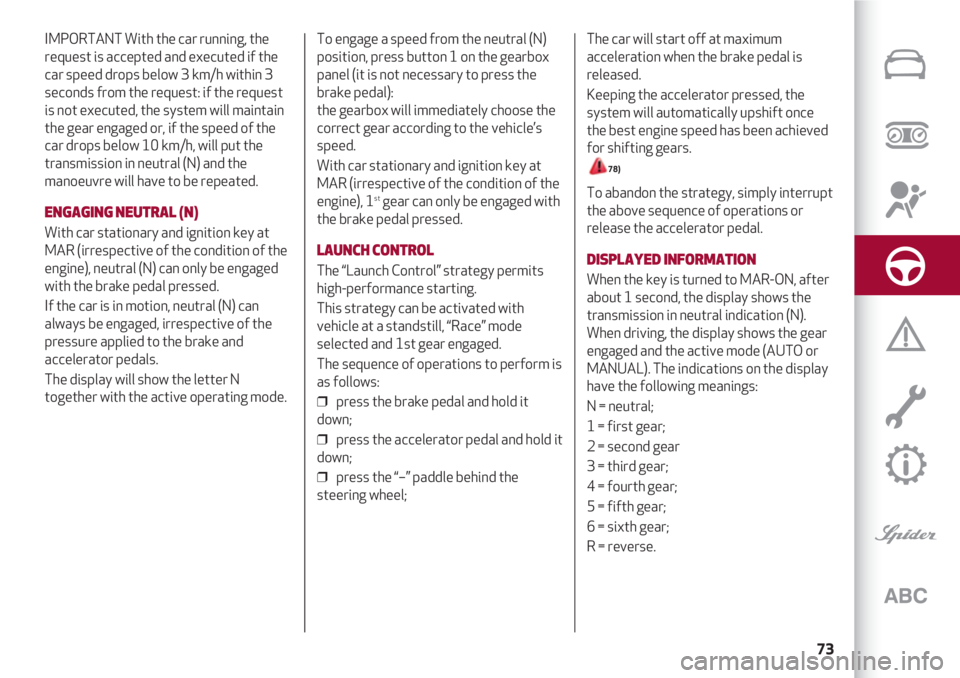
73
IMPORTANT With the car running, the
request is accepted and executed if the
car speed drops below 3 km/h within 3
seconds from the request: if the request
is not executed, the system will maintain
the gear engaged or, if the speed of the
car drops below 10 km/h, will put the
transmission in neutral (N) and the
manoeuvre will have to be repeated.
ENGAGING NEUTRAL (N)
With car stationary and ignition key at
MAR (irrespective of the condition of the
engine), neutral (N) can only be engaged
with the brake pedal pressed.
If the car is in motion, neutral (N) can
always be engaged, irrespective of the
pressure applied to the brake and
accelerator pedals.
The display will show the letter N
together with the active operating mode.To engage a speed from the neutral (N)
position, press button 1 on the gearbox
panel (it is not necessary to press the
brake pedal):
the gearbox will immediately choose the
correct gear according to the vehicle’s
speed.
With car stationary and ignition key at
MAR (irrespective of the condition of the
engine), 1
stgear can only be engaged with
the brake pedal pressed.
LAUNCH CONTROL
The “Launch Control” strategy permits
high-performance starting.
This strategy can be activated with
vehicle at a standstill, “Race” mode
selected and 1st gear engaged.
The sequence of operations to perform is
as follows:
❒ press the brake pedal and hold it
down;
❒ press the accelerator pedal and hold it
down;
❒ press the “–” paddle behind the
steering wheel;The car will start off at maximum
acceleration when the brake pedal is
released.
Keeping the accelerator pressed, the
system will automatically upshift once
the best engine speed has been achieved
for shifting gears.
78)
To abandon the strategy, simply interrupt
the above sequence of operations or
release the accelerator pedal.
DISPLAYED INFORMATION
When the key is turned to MAR-ON, after
about 1 second, the display shows the
transmission in neutral indication (N).
When driving, the display shows the gear
engaged and the active mode (AUTO or
MANUAL). The indications on the display
have the following meanings:
N = neutral;
1 = first gear;
2 = second gear
3 = third gear;
4 = fourth gear;
5 = fifth gear;
6 = sixth gear;
R = reverse.
Page 76 of 156
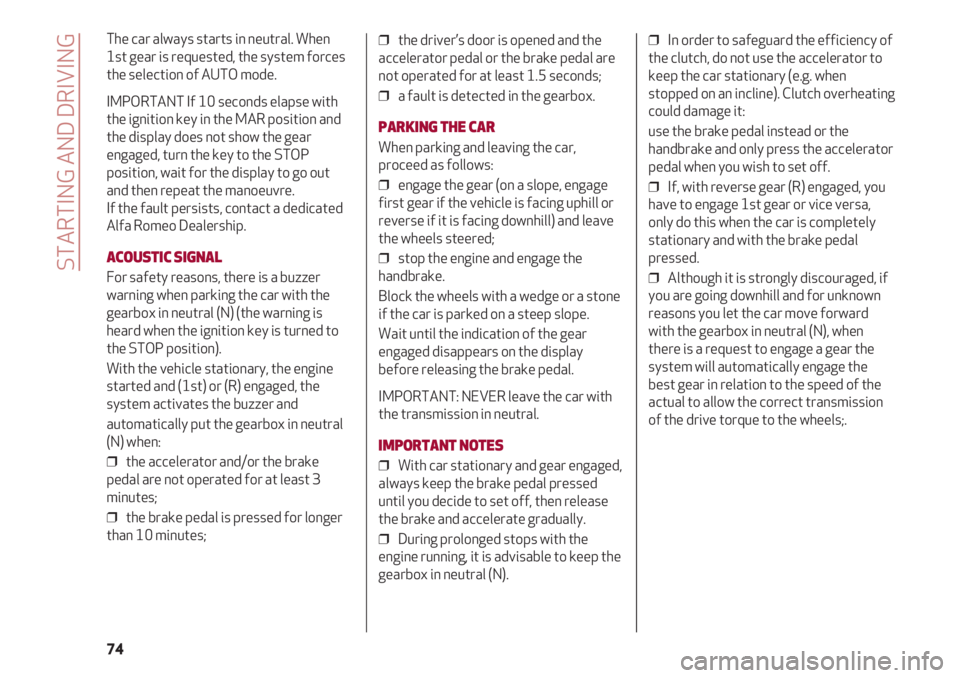
STARTING AND DRIVING
74
The car always starts in neutral. When
1st gear is requested, the system forces
the selection of AUTO mode.
IMPORTANT If 10 seconds elapse with
the ignition key in the MAR position and
the display does not show the gear
engaged, turn the key to the STOP
position, wait for the display to go out
and then repeat the manoeuvre.
If the fault persists, contact a dedicated
Alfa Romeo Dealership.
ACOUSTIC SIGNAL
For safety reasons, there is a buzzer
warning when parking the car with the
gearbox in neutral (N) (the warning is
heard when the ignition key is turned to
the STOP position).
With the vehicle stationary, the engine
started and (1st) or (R) engaged, the
system activates the buzzer and
automatically put the gearbox in neutral
(N) when:
❒ the accelerator and/or the brake
pedal are not operated for at least 3
minutes;
❒ the brake pedal is pressed for longer
than 10 minutes;❒ the driver’s door is opened and the
accelerator pedal or the brake pedal are
not operated for at least 1.5 seconds;
❒ a fault is detected in the gearbox.
PARKING THE CAR
When parking and leaving the car,
proceed as follows:
❒ engage the gear (on a slope, engage
first gear if the vehicle is facing uphill or
reverse if it is facing downhill) and leave
the wheels steered;
❒ stop the engine and engage the
handbrake.
Block the wheels with a wedge or a stone
if the car is parked on a steep slope.
Wait until the indication of the gear
engaged disappears on the display
before releasing the brake pedal.
IMPORTANT: NEVER leave the car with
the transmission in neutral.
IMPORTANT NOTES
❒ With car stationary and gear engaged,
always keep the brake pedal pressed
until you decide to set off, then release
the brake and accelerate gradually.
❒ During prolonged stops with the
engine running, it is advisable to keep the
gearbox in neutral (N).❒ In order to safeguard the efficiency of
the clutch, do not use the accelerator to
keep the car stationary (e.g. when
stopped on an incline). Clutch overheating
could damage it:
use the brake pedal instead or the
handbrake and only press the accelerator
pedal when you wish to set off.
❒ If, with reverse gear (R) engaged, you
have to engage 1st gear or vice versa,
only do this when the car is completely
stationary and with the brake pedal
pressed.
❒ Although it is strongly discouraged, if
you are going downhill and for unknown
reasons you let the car move forward
with the gearbox in neutral (N), when
there is a request to engage a gear the
system will automatically engage the
best gear in relation to the speed of the
actual to allow the correct transmission
of the drive torque to the wheels;.